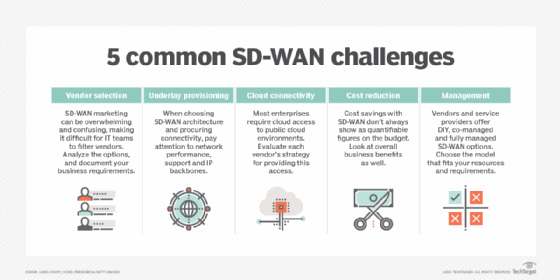
pixel - Fotolia
SD-WAN industry growth opens partner opportunities in 2021
Channel partners can take advantage of SD-WAN industry expansion by addressing customers' interoperability and security concerns, according to Spirent Communications executives.
SD-WAN technology offers enterprises the ability to more easily deploy network resources and align with the industry movement toward cloud computing. Interest in SD-WAN increased dramatically in 2020, in part because of the COVID-19 pandemic. However, organizations continue to have concerns about the technology's interoperability and security capabilities, which have opened new opportunities for savvy channel partners.
SD-WAN continues to be an appealing option as organizations' networks grow larger, more complex and difficult to manage. "An important reason that we need SD-WANs is to simplify the method of making connections with today's widely dispersed, rapidly changing computer infrastructure," said Aleksander Gorkowienko, managing consultant of SecurityLabs at Spirent Communications, a provider of automated testing and assurance technology.
Among the benefits of SD-WAN technology is the ability to gain easier access to the cloud by decoupling software from hardware, according to Marc Cohn, senior technology strategist at Spirent Communications. "SD-WAN architectures provide, loosely speaking, an on-ramp to the cloud," he said.
He added that SD-WANs also have a modern architecture, provide companies with flexibility and have the ability to automate tedious configuration tasks.
The technology has become a popular foundation for remote connections. As a result of the need for remote workforces during the pandemic, SD-WAN adoption sped up. "COVID-19 emerged as a once-in-a-lifetime disruption to life as we knew it, but also dramatically accelerated enterprise migration to the cloud," Cohn said.
Edges need to be smoothed out
Despite SD-WAN market growth, the technology has some rough edges to it still. "The SD-WAN market and customer base is now encountering new areas beyond their comfort zone," Gorkowienko said.
One challenge is the absence of comprehensive standard SD-WAN protocols. "All current SD-WAN solutions are proprietary, which -- in turn -- results in vendor lock-in," he said.
In 2021, the SD-WAN industry will try to address the technology's shortcomings. For example, SD-WAN vendors will attempt to manage SD-WAN system interfaces and its virtualized services more effectively, according to Spirent Communications. Provisioning needs to be automated, so, ideally, customers spend no time on it.
Security is also a pressing concerning. When corporations quickly moved employees from the office to work-from-home setups, a major security hurdle arose. Businesses needed to ensure such connections remained secure, even though they had little to no control over how they were configured.
Inadequate SD-WAN implementations or configurations can expand the network attack surface and potentially exposes businesses to threats, Gorkowienko said.

SD-WAN standards emerge
A few possible SD-WAN standards have begun to take shape. The Metro Ethernet Forum (MEF), a vendor and user consortium operating since 2001 and focused on WAN network standards, has been working on two standards:
- SD-WAN Security Standard, or MEF 88, is designed to provide standard connections from enterprise networks to carrier services. The standard creates policies for IP packets entering WAN services, determines how they are classified into application flows and understands how to forward them based on their configuration and acceptable use policies.
- Secure Access Service Edge (SASE) is an emerging network architecture that outlines how security features should be implemented in SD-WANs. The specification works in conjunction with nine other MEF standards covering areas like application security, a zero-trust framework and policy based orchestration.
What next?
Organizations that implement SASE will realize many benefits, Cohn said, including the following:
- much higher scalability than legacy VPNs;
- substantially reduced latency, eliminating the need for backhauling service;
- streamlined client endpoints, as security functions are offloaded to the cloud;
- centralized and simplified management; and
- simpler deployment and maintenance.
Enterprises have begun to tinker with MEF-88 and SASE. "What enterprises will discover as they embrace SD-WANs is that operationizing them is much different than traditional network services," Cohn noted. Consequently, an opportunity has opened for channel partners to become their trusted advisors in these implementations, he said.






